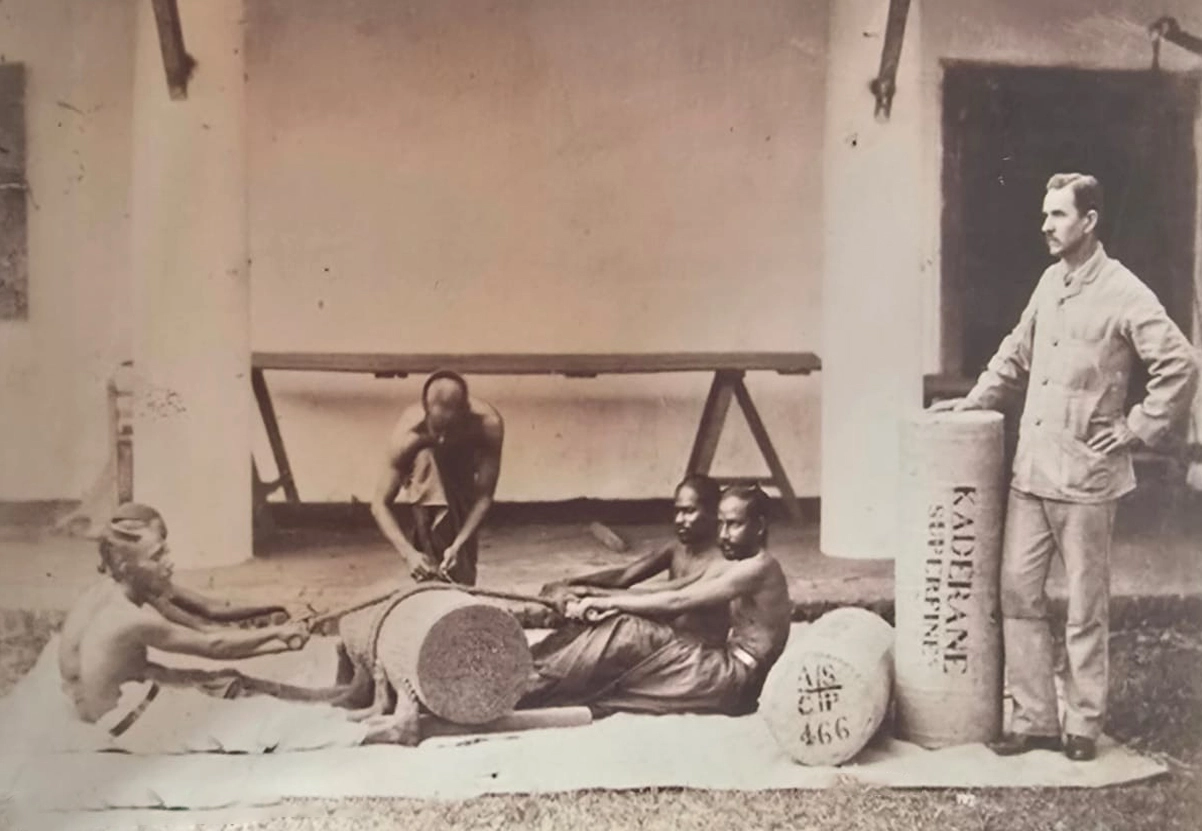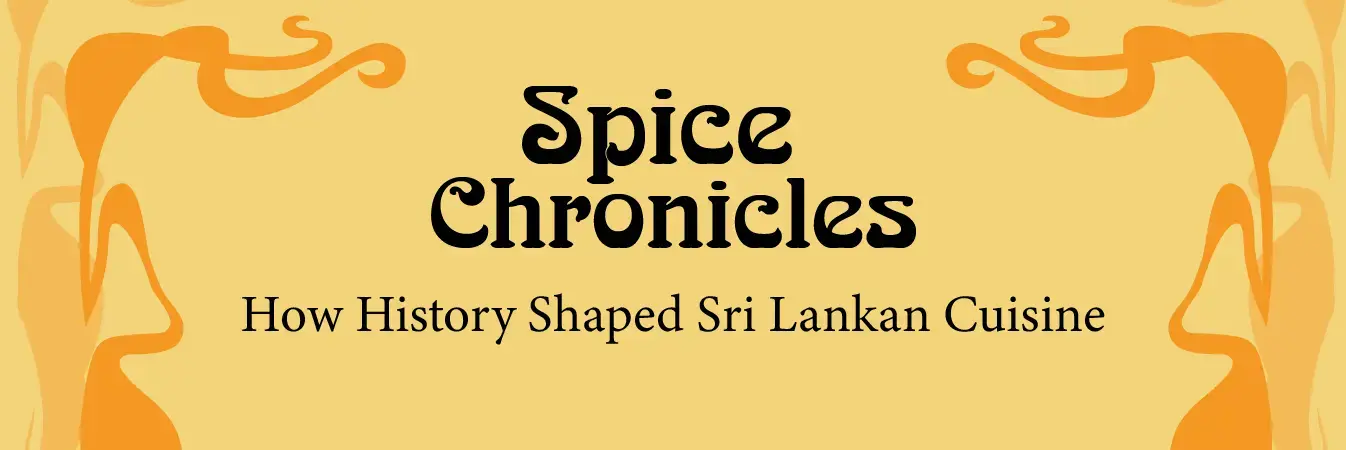Spice Chronicles: How History Shaped Sri Lankan Cuisine
A Journey of Flavors and Heritage at Thambili House, Galle Fort
Sri Lanka’s food is a celebration of history, culture, and the island’s enviable position along ancient trade routes. Over centuries, Dutch, English, Malay, and Indian influences blended with local traditions to create the vibrant and flavorful cuisine we cherish today. This rich culinary story is at the heart of Spice Chronicles: A Culinary Tale of Sri Lanka’s Past, a one-of-a-kind event hosted at Thambili House by Edwards Collection, happening from February 6th to 9th.
This event is brought to life through a creative partnership with Nostalgia.lk, whose storytelling and conceptual design weave together history, art, and food. Nostalgia.lk has curated a captivating narrative that connects colonial-era paintings with a specially designed menu, offering guests a chance to experience Sri Lanka’s heritage through both visuals and flavors.
Have you ever wondered how Sri Lanka became the Spice Island of the world? At Spice Chronicles, you’ll discover the answer while savoring dishes infused with centuries-old flavors.
The Evolution of Sri Lankan Cuisine
Sri Lanka’s culinary heritage is a vibrant medley of flavors, deeply influenced by its history as a central hub of global trade and cultural exchange. Known historically as "The Spice Island," Sri Lanka attracted ancient traders from Arabia, China, and India as early as the 2nd century AD, drawn by its abundance of cinnamon, pepper, nutmeg, and cloves. Over the centuries, Portuguese, Dutch, and British colonial powers fought fiercely for control of this lucrative spice trade. Every dish and spice tells a story, reflecting the island's encounters with traders, colonizers, and neighboring cultures, preserving the essence of those who once called this island home.
Galle Fort, a UNESCO World Heritage Site, stands as a testament to Sri Lanka’s rich history as a global spice trading hub. Built by the Portuguese in 1588 and later fortified by the Dutch in the 17th century, the fort became a strategic centerpiece in the fierce competition among Portuguese, Dutch, and British colonial powers for control over the island’s lucrative spice trade. During the 16th and 17th centuries, cinnamon—one of Sri Lanka's prized spices—was considered more valuable than gold, underscoring the fort’s importance in shaping the island's economic and cultural legacy.
The Dutch brought with them rich and hearty dishes, such as lamprais, a combination of spiced rice, meat curry, and accompaniments wrapped in a banana leaf. This iconic dish continues to thrive, embodying the colonial fusion of local spices with European flavors.
Although Lamprais was not originally imported from Holland, it does incorporate aspects of Dutch culinary traditions. Rather, Lamprais is an amazing blend of flavors and culinary customs that came to Sri Lanka as a result of the spice trade.
Did you know? During Dutch rule in the 17th century, cinnamon harvested in Sri Lanka was considered the finest in the world, and Galle Fort served as a key port for exporting this ‘golden spice’ to Europe.

The English Connection
From tea plantations to high tea traditions, the British left an indelible mark on Sri Lanka’s food culture. The tradition of afternoon tea lives on in fine scones, buttery shortbreads, and savory pastries—all elevated with a Sri Lankan twist of cinnamon, cardamom, and cloves.
Malay Contributions
The Malay community introduced fragrant dishes like sambal and Malay pickle, which perfectly balance sweet, sour, and spicy flavors. These additions enriched local cuisine with complex layers of taste.
Indian Heritage
India, just across the water, has influenced Sri Lankan food in profound ways. From the use of spices like cumin and coriander to dishes like parippu (lentil curry), Indian influence is inseparable from the essence of Sri Lankan cuisine.
What Awaits You at Spice Chronicles?
1. A Culinary Celebration
At Spice Chronicles, embark on a gastronomic journey through Sri Lanka's rich and diverse food heritage, brought to life through a specially curated menu. Each dish pays homage to the island’s cultural influences and historical ties to the global spice trade. Highlights include:
- High Tea: Indulge in Dutch-inspired pastries and British tea traditions infused with Sri Lankan spices. A must-try is Halapa, a beloved Sri Lankan snack made from a simple yet flavorful combination of kurakkan flour (finger millet), grated coconut, and jaggery (palm sugar). This mixture is delicately wrapped in kanda leaves (a type of medicinal leaf) and gently steamed, giving halapa its subtle earthy aroma and unique charm.
- Cocktails: Savor handcrafted drinks inspired by cinnamon, nutmeg, and other iconic spices, each with a story of trade and exploration. Don’t miss the coconut margarita with a hint of nutmeg—a tropical masterpiece!
- Signature Dishes: Discover reimagined classics like lamprais, sambal, and spiced desserts that beautifully blend colonial influences with local flavors. The "King's Meal" is a feast packed with nutrition and bursting with flavor, celebrating the essence of Sri Lanka's culinary identity.
Each dish on the Spice Chronicles menu is inspired by the stories behind colonial-era paintings, such as the bustling spice markets or tranquil tea plantations that defined Sri Lanka’s heritage.
2. Spice Route through All five Senses
See – A Kaleidoscope of Colors: As you journey through the spice route, your eyes feast on a vibrant tapestry of colors—deep reds of sun-dried chilies, golden yellows of turmeric, and rich browns of cinnamon sticks curled into delicate spirals. Explore the visual journey of spice route through our curated images on display.
Taste – A Symphony on the Tongue: Each dish is prepared to highlight the flavors that made their way through the world and became essential to Sri Lankan cuisine. The flavors of the spice route are bold, complex, and unforgettable. A pinch of saffron dissolves into warm milk, creating a delicate floral sweetness, while the sharp heat of black pepper tingles on your tongue. Cinnamon, cardamom and cloves bring a soothing warmth to tea, while the smoky depth of cumin lingers in every bite of a rich curry.
Smell – Aromas of the Ancient World: These scents transport you to distant lands, where traders once bartered for sacks of aromatic treasures that would transform kitchens around the world.The rich scent of cinnamon candles will permeate the air, evoking the opulence that was previously only afforded to Sri Lankan royalty in the past.
Hear – The Song of the Spice Market: The varied customs that shaped the island through the spice trade will be reflected in the carefully chosen playlist of Sri Lankan music. The hiss of cinnamon-infused tea being poured into a cup and the sizzle of chili-infused oil tell their own stories, each sound a note in the symphony of the spice trade.
Touch – Textures of the Trade: Visitors will be able to touch and handle the most priceless spices that have been traded along these routes for centuries; spices that likely formed the portfolio of the merchant who lived in this very house three centuries ago.
3. An Exhibition of Colonial-Era Art
The event offers guests the unique opportunity to explore an exclusive exhibition of colonial-era paintings, each reflecting the cultural exchanges that shaped Sri Lanka’s identity. Guests can immerse themselves in the artwork and use it as inspiration to choose from a curated menu of high tea, signature dishes, or cocktails—each thoughtfully designed to complement the stories and themes of the paintings. This blend of art and cuisine creates a truly personalized and immersive journey into Sri Lanka’s past.
4. The Setting: Thambili House – Galle Fort, The Spice Merchant’s House
Thambili House, located within the historic Galle Fort, a UNESCO World Heritage Site, is a 300-year-old spice merchant’s house originally built during Sri Lanka’s time as the world’s only source of prime-quality cinnamon; restored by Rohan Aluwihara, a protégé of Geoffrey Bawa, this luxurious two-storied villa boasts uneven walls, cut cement floors, antique ebony and calamander furniture from the 16th to 18th centuries, and contemporary local art, offering three exquisitely designed air-conditioned suites—Cinnamon, Nutmeg, and Ginger—each reflecting the villa's connection to the spice trade; with breathtaking views of the southern Indian Ocean, a private pool, proximity to landmarks such as the 300-year-old Masjid Meera Jumma Mosque and the iconic Galle Lighthouse, and the ability to accommodate up to 8 guests as a fully exclusive rental, Thambili House is a haven of comfort, refinement, and history, combining its colonial past with modern elegance for discerning visitors.
Why This Event Matters at Galle Literary Festival 2025
As Sri Lankans, we take immense pride in our culinary heritage. Sri Lankan cuisine is not just about food—it’s about the stories, cultures, and histories that have shaped it over centuries. Spice Chronicles invites you to uncover the roots of these rich flavors while indulging in the unmatched luxury of Thambili House.
The Galle Literary Festival 2025 provides the perfect platform to educate and engage the literary community, offering a unique opportunity to connect with individuals who have a deep appreciation for culture, history, and storytelling. This event aims to amaze, inspire, and create meaningful connections through the lens of our culinary and cultural legacy.
___________________________________________________________________________
Event Details
Dates : February 6th – 9th, 2025
Location : Thambili House, Galle Fort (Google Map)
Experiences : Exhibition of colonial-era paintings, high tea, signature cocktails, and a curated menu inspired by history.
Reservations : 0770707090 (WhatsApp Link)
___________________________________________________________________________
Sri Lanka’s culinary heritage is a testament to its history, shaped by cultures from across the world. Join us at Spice Chronicles, in partnership with Nostalgia.lk, to experience this unique blend of art and flavor. Don’t just taste history—immerse yourself in it.
Let us take you on a journey through Sri Lanka’s rich past, one sip and one bite at a time, as Nostalgia.lk brings stories to life through art, cuisine, and creativity.
